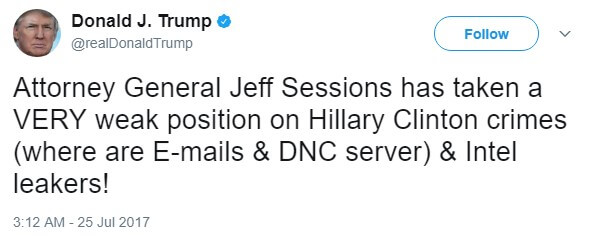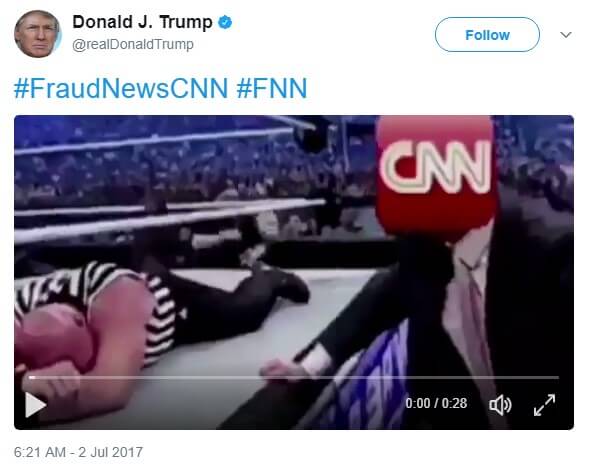President Trump took the unusual step this week of calling out his own hand-picked appointee, Attorney General Jeff Sessions, on Twitter:

CNN, reporting on the tweet, displayed this banner on air: TRUMP CALLS AG SESSIONS “VERY WEAK”
Any reasonable person can see that this is an intentionally dishonest read of the President’s statement. The original tweet was controversial enough. The sensationalism was unnecessary. And it is precisely this sort of exaggeration that boosts Donald Trump’s credibility when referring to CNN and other media outlets as “fake news.”
Media credibility suffers
You can blame click-driven journalism for this trend, or increased competitiveness for dwindling cable audiences, but the mainstream media’s decisions have already had consequences for their industry.
A Gallup poll from April 2017 reveals a startling lack of trust in media. More than 6-in-10 Americans say the news media favors one party over another; just 27 per cent have “a great deal” or “quite a lot” of confidence in newspapers; less than 1 in 4 has “high confidence” in television news.
The Pew Centre’s numbers, from May, are similar: 87 per cent of Republicans and 53 per cent of Democrats believe the news media favors one party. Worse, just 11 per cent of Republicans and only 34 per cent of Democrats consider national news media to be “very trustworthy”.
And CNN has fared the worst. They’re currently drawing much smaller audiences than Fox News or MSNBC. By pursuing attention-grabbing headlines at the expense of accuracy, CNN’s credibility has suffered.
So perhaps it is not surprising when, in late June, after three CNN journalists were forced to resign for a retracted story about Trump and Russia, the President seized his chance to prey on the network’s weakness.
The tweet heard around the world
At 9:22 AM, on the morning of July 2nd the president tweeted a photoshopped video of a 2007 Wrestlemania match starring himself (who, at the time was an occasional WWE guest star) and WWE founder Vince McMahon. The video shows Trump throwing punches at McMahon with a CNN logo superimposed over his face.

Hours later, Trump retweeted it from the official presidential account (@POTUS). Since then, the original tweet has racked up 370,000 retweets and more than 603,000 post likes, making it one of Trump’s most popular tweets of all time.
Beneath the humorous video, though, the tweet carries a serious psychological subtext : CNN is just as fake as pro wrestling.
CNN’s reaction – to go on the defensive – only exacerbated the problem.
The media, predictably, were apoplectic. CNN even complained to Twitter to see if the offending tweet could be taken down for inciting violence. Without a trace of irony, the network did this even after giving extensive and uncritical coverage to Kathy Griffin’s faux beheading, and to the ‘Trump as Julius Caesar’ play in Central Park – both of which presented far more graphic scenes of political violence than Trump’s video.
In the days that followed, CNN traced the video’s source back to a single Reddit user and threatened to reveal his identity. What a sad commentary on the state of the news media in 2017: a corny wrestling video leads a national news organization to threaten to dox (online slang for revealing an individual’s personal information) a private citizen. The result? CNN was criticized from both the right and left — and the president’s wrestling video looked less goofy than the network’s reaction to it.
In the end, CNN got played by Trump and the bodyslam video. The media didn’t know how to react, and, instead, did little more than give the President four days of free coverage on its network, all the while energizing Trump’s supporters..
Trump knows exactly how to seize control of the media cycle
Even if the mainstream news media play the role of an opposition party to Donald Trump, the president has one effective lever at his disposal to provide counterbalance.
With 34.5 million Twitter followers (plus an additional 20 million on the official @POTUS account), Trump has the capacity to share his unfiltered message with a single keystroke and co-opt the news networks into covering his own words.
And when Trump tweets, it instantly shapes the public debate.
Each Wrestlemania-type post energizes Trump’s large and passionate Reddit and Twitter followings. They whip up enthusiastic support online, and spin off endless memes, predominantly among his younger fans.
Where this goes from here
There is a darker side to the president’s capacity to play the news media. Sadly, substantive news coverage may be the number one victim. The President’s more tangential “tweetstorms” are often distractions that divert media coverage from more important issues in the news – what was the public benefit of knowing whether Joe Scarborough and Mika Brzezinski visited Mar-a-Lago?
Erosion in trust in the media is obviously the longer-term concern, but it is one that is equally in the hands of the media to repair. For their part, they can start by rethinking banners like Trump calls AG Sessions ‘Very Weak.” It’s a two-way street, after all. As a White House spokesperson indicated after Trump’s recent tangle with Brzezinski, the president views his actions as “punching back” rather than starting the fight.
And the media needs to play a role in righting their ship, in part because we should not otherwise expect the CNN-taunting to stop. The weaker they are, the more Trump sees it as a winnable fight. As former White House Press Secretary Ari Fleischer recently tweeted after the Wrestlemania incident:
“The reason POTUS does it is because the press has made themselves so unpopular. It’s a fight POTUS actually wins w much of the country.”
So perhaps it’s not a channel changer, but more of a strategy. Perhaps it’s part of what President Trump means when he says his style is “modern day presidential”. In any case, President Trump is fighting the media’s sensationalism with his own. A series of his tweets from July 1 may shed light on his thought process:
“The FAKE & FRAUDULENT NEWS MEDIA is working hard to convince Republicans and others I should not use social media – but remember, I won … the 2016 election with interviews, speeches and social media. I had to beat #FakeNews, and did. We will continue to WIN!”
In President Trump’s view, bypassing and attacking the media is a feature, not a bug. What’s unclear is who will sustain the most collateral damage on the way to 2018 and 2020.
